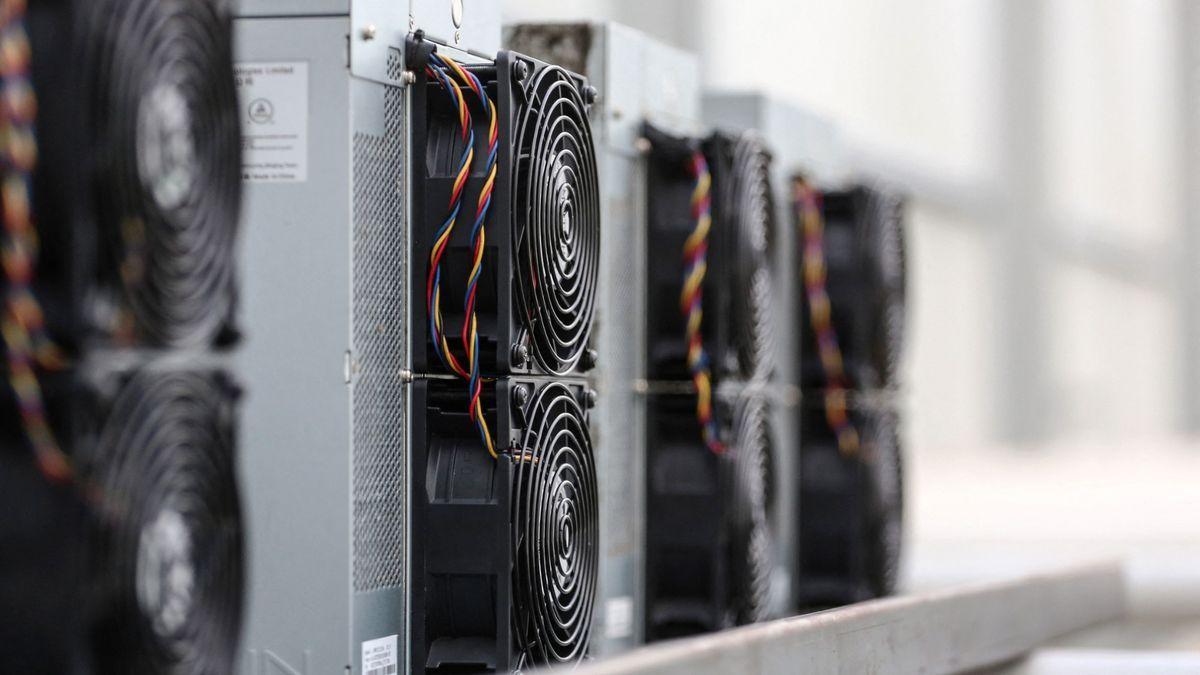TeraWulf's Zero-Carbon Bitcoin Mining and AI Potential
2 Sources
2 Sources
[1]
EXCLUSIVE: Terawulf CSO Talks Zero-Carbon Bitcoin Mining And The Opportunity In AI, HPC
Terawulf targets further increasing its infrastructure capacity by an additional 300 MW in the near term Bitcoin has been on a steady recovery since falling below $55,000 some two weeks ago amid the German government's massive $BTC selloffs, and along with the digital currency's gradual climb, the spotlight has also been shining brighter on the industry behind the coin's life: Bitcoin mining. Bitcoin mining - the backbone of the network Mining Bitcoins, which involves the complex process of miners discovering new blocks, verifying transactions, and earning $BTC rewards by competition, has long been under the watchful eye of environmentalists who have accused the industry of dealing a heavy blow to the environment due to its high energy consumption and emissions. However, a large number of miners have been transitioning toward zero-carbon operations and some, like infrastructure-focused Bitcoin mining company Terawulf, are very close to becoming a 100% zero-carbon operations firm. In an exclusive with International Business Times, Terawulf Chief Strategy Officer Kerri Langlais shared how the company has been working toward its sustainable operations goals and why diversifying is critical for the industry at this point. Location is everything Transitioning to more sustainable mining operations can be very costly, especially for smaller miners. When shifting to renewable energy sources for more sustainable operations, Langlais noted that "location is everything." "Most renewable energy sources are situated in remote rural areas where there is typically a supply/demand imbalance, requiring efficient utilization to avoid wastage. Bitcoin mining is location-agnostic and operates independently of time constraints. It optimizes for cost-effective power sources, making it highly adaptable within the grid," she said. Powering the hardware working to uncover new blocks is the most expensive part of Bitcoin mining operations. To help reduce transition costs, a path forward is choosing cheaper energy sources. According to the International Renewable Energy Agency (IRENA), renewable power has become more competitive in recent years. "Around 86 percent (187) gigawatts of all the newly commissioned renewable capacity in 2022 had lower costs than fossil fuel-fired electricity," it said in a mid-2023 report. Renewable sources from a strategically chosen location can help optimize Bitcoin mining operations, helping miners balance their expenses with the growing competition since the April halving, Langlais said. As of July, Terawulf utilizes 95% zero-carbon energy resources including nuclear, hydro, and solar to fuel its operations. The ultimate goal is to utilize 100% zero-carbon energy. Finding opportunity in power competition Since the halving that split mining rewards in half, competition has skyrocketed and some small miners have struggled to retain operations due to high operational costs. Another competitive wave has taken over the mining sector as demand for artificial intelligence doubled the work for data centers. Langlais acknowledged that "competition for energy resources between Bitcoin miners and AI data centers is intensifying." She said the competition has led AI data centers, as led by "hyperscalers like Microsoft and Google," to rapidly secure any available power capacities, leaving crypto miners with scarcity and increased costs. Instead of being caught up in the competition, Terawulf found an opportunity in the chaos. Due to its substantial energy infrastructure at its Lake Mariner facility in New York that is poised for immediate deployment of up to an additional 300 MW (megawatts) - beyond the 200 MW of Bitcoin mining currently in operation - which contrasts with the long development timelines required for new power sources, it has become a sought-after provider by some hyperscalers. Langlais noted that dabbling into high-computing ventures as the demand around AI skyrockets doesn't mean Terawulf is refocusing. "We view this not as a strategic shift, but rather as an evolution of our core energy infrastructure competencies," he said. "Reflecting on our $BTC mining endeavors, our primary value proposition has always been providing low-cost, zero-carbon energy and scalable data center infrastructure. Historically, we have utilized this infrastructure to convert energy into has power or $BTC. Similarly, we perceive AI and HPC (high-performance computing) as opportunities to provide power, cooling, and fiber infrastructure at a high density and scale, converting electricity into compute power or data tokens. Upon evaluating the potential returns, we find this opportunity highly compelling," she said. Eliminating debt for a strategic future As Terawulf balances its Bitcoin mining operations and converting electricity for computing power ventures, the company looks to expand, especially after it recently made its final debt payment. The company now has no outstanding debt, and Langlais said it was "a critical milestone" for Terawulf to achieve. It now has the financial flexibility to scale and deploy its low-cost energy infrastructure not just for Bitcoin mining but for HPC and AI applications. Langlais revealed that the company seeks to expand its operational infrastructure capacity from 250 MW currently to 295 MW, with the goal of further increasing its capacity by an additional 300 MW in the near term. Toward a sustainable, diversified future Survival has become a challenge for many miners since the halving. Langlais said some smaller public $BTC miners have explored mergers and acquisitions (M&A) partnerships to stay afloat and keep thriving in the now highly competitive environment. There is a growing trend among traditional miners to diversify revenue as a means to survive, and for Terawulf, such a route is through integrating HPC and AI applications into its operations.
[2]
Can Bitcoin miners turn AI data centres into a new goldmine? | bobsguide
In recent months, Bitcoin mining companies have begun pivoting towards developing AI data centres. This strategic shift is driven by the reduced profitability following the latest Bitcoin halving. Major players like Core Scientific and Iris Energy are already integrating AI into their operations. The pivot leverages miners' significant energy resources and infrastructure, offering a new revenue stream and business stability. So far, these pivots have been warmly received by investors, leading to the market cap of 14 major bitcoin mining companies jumping in value by 22%, or $4 billion, since the beginning of June, J.P. Morgan reported on June 24. This trend is expected to grow, presenting new opportunities for the industry. As AI demand surges, Bitcoin miners are well-positioned to capitalise on their existing capabilities, making this transition both logical and potentially lucrative. The latest Bitcoin halving event has significantly impacted the profitability of Bitcoin mining. This technical update, which occurs approximately every four years, reduces the rewards miners receive for validating transactions by half. As a result, many miners are struggling to maintain profitability. High energy costs and reduced rewards have exacerbated the financial strain on mining operations. For instance, Core Scientific, one of the largest Bitcoin miners, faced bankruptcy in 2022 due to these challenges. The halving has forced miners to seek alternative revenue streams, with AI data centres emerging as a viable solution. The pivot to AI allows miners to leverage their existing infrastructure and energy resources, providing a more stable and potentially lucrative business model. This transition is not without its risks, but the growing demand for AI capabilities offers a promising opportunity for miners to diversify and stabilise their revenue streams in an increasingly competitive market. Transitioning to AI data centres comes with its own set of advantages for Bitcoin miners. Firstly, they have secured large amounts of power supply, controlling about 6 gigawatts (GW) of power access, with projections to reach 12 GW by 2027, according to a Berstein report. This extensive energy capacity is crucial for the high computational demands of AI operations. Additionally, Bitcoin mining facilities are equipped with high power density racks and advanced cooling infrastructure, making them ideal for retrofitting into AI data centres. Moreover, miners have developed robust data centre operating capabilities, which can be seamlessly adapted to support AI workloads. This expertise in managing large-scale, power-intensive operations positions them as attractive partners for AI companies. For example, Core Scientific's 12-year agreement with CoreWeave highlights the potential for lucrative partnerships. By leveraging their existing infrastructure and energy resources, Bitcoin miners can diversify their revenue streams and capitalise on the growing demand for AI capabilities, ensuring business stability and growth. Several key players are leading the transition from Bitcoin mining to AI data centres. Core Scientific, one of the largest Bitcoin miners, has aggressively pursued AI deals, including the abovementioned 12-year agreement with CoreWeave. This partnership is projected to generate $4.7 billion in revenue, highlighting the lucrative potential of such collaborations. CoreWeave, a former crypto miner, has successfully pivoted to AI, raising its valuation to $19 billion. Another notable player is Iris Energy, which has received an outperform rating from broker Bernstein, reflecting confidence in its strategic shift towards AI. Hut 8, based in Miami, has also made significant strides, securing a $150 million investment from Coatue Management to upgrade its infrastructure for AI needs. The market dynamics are favourable, with AI companies seeking high-performance computing capabilities that miners can provide. Analysts expect 20% of Bitcoin miners' power capacity to pivot to AI by 2027, indicating a robust future for this transition. This shift not only diversifies revenue streams but also stabilises the business, making it a promising avenue for miners. The increasing energy consumption of both Bitcoin mining and AI data centres on the other hand raises significant environmental concerns. Large-scale cryptocurrency operations in the U.S. consume over 2% of the nation's electricity, equivalent to adding another state to the power grid. The International Energy Agency projects that combined energy use for data centres, crypto, and AI could double by 2026, reaching nearly 2% of global energy demand. This surge in energy consumption underscores the need for sustainable practices. Some companies, like Terawulf, are focusing on green energy solutions, but the overall environmental impact remains a critical issue for the industry. By transitioning to AI data centres, Bitcoin miners are not only weathering the current challenges but also positioning themselves for a future where Bitcoin and AI thrive together. This approach unlocks exciting and unforeseen opportunities for the industry. One thing is clear: Bitcoin miners are brimming with innovative ideas to remain viable.
Share
Share
Copy Link
TeraWulf, a Bitcoin mining company, is exploring zero-carbon mining practices and potential expansion into AI and high-performance computing. This move highlights the evolving landscape of cryptocurrency mining and its intersection with emerging technologies.

TeraWulf's Sustainable Bitcoin Mining Approach
TeraWulf, a prominent player in the Bitcoin mining industry, is making waves with its commitment to zero-carbon mining practices. The company's Chief Strategy Officer, Kerri Langlais, recently shared insights into their innovative approach, which leverages nuclear and hydro power sources to minimize environmental impact
1
.The Shift Towards Sustainable Cryptocurrency Mining
As concerns about the energy consumption of Bitcoin mining continue to grow, TeraWulf's strategy represents a significant shift in the industry. By utilizing 100% zero-carbon energy, the company aims to address the environmental criticisms often leveled at cryptocurrency mining operations. This approach not only aligns with global sustainability goals but also positions TeraWulf as a leader in responsible mining practices
1
.Exploring AI and High-Performance Computing Opportunities
TeraWulf is not limiting its focus to Bitcoin mining alone. The company is actively exploring opportunities in the rapidly growing fields of artificial intelligence (AI) and high-performance computing (HPC). This strategic move comes as the demand for computational power in these sectors continues to surge
1
.The Convergence of Bitcoin Mining and AI Infrastructure
The potential synergy between Bitcoin mining infrastructure and AI data centers is becoming increasingly apparent. Both industries require substantial computational power and energy resources, leading to a natural overlap in their operational requirements. This convergence is opening up new possibilities for mining companies to diversify their revenue streams
2
.Challenges and Opportunities in the AI Sector
While the AI sector presents exciting opportunities for Bitcoin miners, it also comes with its own set of challenges. The computational needs of AI workloads differ from those of Bitcoin mining, requiring adaptations in hardware and infrastructure. However, the potential for higher profit margins in AI computing makes it an attractive prospect for mining companies looking to expand their operations
2
.Related Stories
The Role of Location and Energy Access
TeraWulf's success in zero-carbon mining highlights the importance of strategic location and access to renewable energy sources. The company's ability to tap into nuclear and hydro power demonstrates how geographical advantages can be leveraged to create more sustainable and cost-effective mining operations. This approach could set a new standard for the industry moving forward
1
.Future Prospects and Industry Implications
As TeraWulf and other mining companies explore diversification into AI and HPC, the landscape of the cryptocurrency mining industry is likely to evolve. This shift could lead to more sustainable practices, increased innovation, and new revenue models for mining operations. It also underscores the adaptability of Bitcoin mining infrastructure and its potential applications beyond cryptocurrency
1
2
.References
Summarized by
Navi
Related Stories
Recent Highlights
1
AI Chatbots Sway Voters More Effectively Than Traditional Political Ads, New Studies Reveal
Science and Research

2
Google AI glasses set to launch in 2026 with Gemini and Android XR across multiple partners
Technology

3
EU Launches Antitrust Probe Into Google's AI Training Practices and Content Usage
Policy and Regulation








